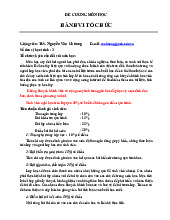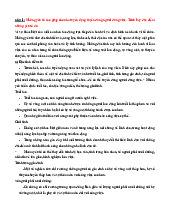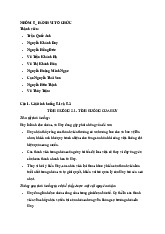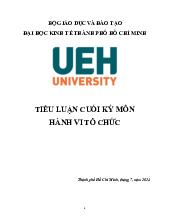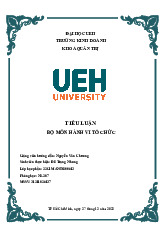



















Preview text:
lOMoAR cPSD| 46578282
THE MINISTRY OF EDUCATION AND TRAINING
UNIVERSITY OF ECONOMICS HO CHI MINH CITY
--------------------------------------- NGUYỄN THỊ CẨM CHÂU
INVESTIGATE CONSUMERS’ IMPULSIVE BUYING BEHAVIOR: A
STUDY ON LIVESTREAM SHOPPING CONTEXT
MASTER THESIS IN BUSINESS ADMINISTRATION Ho Chi Minh City – 2022 lOMoAR cPSD| 46578282 lOMoAR cPSD| 46578282 3
THE MINISTRY OF EDUCATION AND TRAINING
UNIVERSITY OF ECONOMICS HO CHI MINH CITY
--------------------------------------- NGUYỄN THỊ CẨM CHÂU
INVESTIGATE CONSUMERS’ IMPULSIVE BUYING BEHAVIOR: A
STUDY ON LIVESTREAM SHOPPING CONTEXT
Major: Business Administration
Direction: Academic Research Code: 8340101
MASTER THESIS IN BUSINESS ADMINISTRATION
Supervisor: Cao Quốc Việt, Ph.D. Ho Chi Minh City - 2022 lOMoAR cPSD| 46578282 DECLARATION
I hereby declare that this study comprises no information which has been used
for any other academic degree awarded in my name in any educational institution and,
to the best of my knowledge, includes no previous published or written material, except
for reference to other authors’ work. lOMoAR cPSD| 46578282 5 TABLE OF CONTENT
LIST OF ABBREVIATION .......................................................................................... 6
LIST OF TABLES ......................................................................................................... 6
LIST OF FIGURES ....................................................................................................... 7
ABSTRACT .................................................................................................................. 7
CHAPTER 1. INTRODUCTION .................................................................................. 8
1.1. Background ......................................................................................................... 8
1.2. Resreach questions and objectives .................................................................... 11
1.2.1. Research objectives ................................................................................... 11
1.2.2. Research questions ..................................................................................... 11
1.3. Research scope .................................................................................................. 11
1.3.1. Content Scope ............................................................................................ 11
1.3.2. Location Scope ......................................................................................... 12
1.3.3. Time scope ................................................................................................ 12
1.3.4. Research method ....................................................................................... 12
1.3.5. Target population ...................................................................................... 12
1.4. Structure of the study ........................................................................................ 12
CHAPTER 2. LITERATURE REVIEW ..................................................................... 13
2.1. Literature Review ............................................................................................. 13
2.1.1. SOR Theory .................................................................................................. 13
2.1.2. Livestream Shopping Context ...................................................................... 14
2.1.3. Impulsive Buying Behavior .......................................................................... 15
2.2. Summary of prior research ............................................................................... 16
2.3. Hypothesis development and proposed Research Model ................................. 28
CHAPTER 3. RESEARCH METHODOLOGY ......................................................... 37
3.1. Research Process .............................................................................................. 37
3.2. Measuring Item ................................................................................................. 38
3.3. Minimum sample requirements ........................................................................ 41
3.4. Data collection .................................................................................................. 42
3.5. Data analysis method ........................................................................................ 43
CHAPTER 4. FINDINGS ........................................................................................... 43
4.1. Descriptive statistics ......................................................................................... 43 lOMoAR cPSD| 46578282 6
4.2. Measurement model assessment ....................................................................... 45
4.2.1. Reliability test ............................................................................................... 45
4.2.2. Validity test ................................................................................................... 46
4.2.2.1. Convergence Validity ................................................................................. 46
4.2.2.2. Discriminant validity ................................................................................. 46
4.3. Assessment of structural model ........................................................................ 47
4.3.1. Multicollinearity assessment ........................................................................ 48
4.3.2. Coefficient of determination and adjusted R2 ............................................... 48
4.3.3. Effect size f2 .................................................................................................. 49
4.3.4. Predictive relevance Q2 ................................................................................. 49
4.3.5. Path coefficients and hypothesis testing ....................................................... 50
4.4. Discussion ......................................................................................................... 51
CHAPTER 5. IMPLICATIONS .................................................................................. 55
5.1. Theoretical implications ................................................................................... 55
5.2. Managerial implications ................................................................................... 55
5.3. Limitation and direction for future research ..................................................... 56
REFERENCES ............................................................................................................ 57
APPENDIX ................................................................................................................. 63 LIST OF ABBREVIATION IBB Impulsive Buying Behavior II Interpersonal Influence PB Portability PHV Perceived Hedonic Value PUV Perceived Utilitarian Value SC Streamer Characteristic VA Visual Appeal LIST OF TABLES
Table 2.1. Empirical result summary of prior research ........................................... 21
Table 2.2. Prior inconsistent result ......................................................................... 31 lOMoAR cPSD| 46578282 7
Table 3.1. Measurement item & sources ................................................................ 37
Table 4.1. Respondent Demographic ..................................................................... 39
Table 4.2. Loadings, AVE, and reliability results ................................................... 41
Table 4.3. Fornell-Larcker criterion ....................................................................... 42
Table 4.4. Heterotrait-monotrait results (HTMT) ................................................... 43
Table 4.5. Collinearity Statistic (VIF) results ......................................................... 44
Table 4.6. R2 and Q2 results ................................................................................... 44
Table 4.7. Effect size f2 .......................................................................................... 45
Table 4.8. Summary of hypotheses testing ............................................................. 47
Table 4.9. Research results comparison ................................................................. 49 LIST OF FIGURES
Figure 2.1. Proposed research model...................................................................... 32
Figure 3.1. Research process .................................................................................. 33
Figure 4.1. PLS results for research model...............................................................46 ABSTRACT
This study examines how the consumers’ perceived values (utilitarian and
hedonic values) impact their impulse buying behavior (IBB) in the livestream
commerce context by drawing on stimulus-organism-response (S-O-R) paradigm.
Moreover, the author view interpersonal influence as a moderator and test its impact on
the correlation between the consumers’ perceived value and their IBB. Data were
collected through a survey in Ho Chi Minh city (n = 276). The results show that
environmental stimuli (portability, visual appeal, streamer characteristic significantly
influence consumer perceived values (perceived utilitarian value and perceived hedonic
value), and then consumer perceived values significantly and directly impacts their
IBB. In addition, the result indicated that interpersional influence had no significant
moderate effect of PHV and Puv on IBB. Discussions, limitations, and implications are
also presented in the paper. The findings provide valuable guidance for livstream
commerce retailers to induce consumer IBB. lOMoAR cPSD| 46578282 8
Keywords: Livestream commerce, Impulse buying behavior, Consumer
perceived value, Interpersonal influence CHAPTER 1. INTRODUCTION 1.1. Background
There have been significant developments in technology and its adoption in
recent years, whether for business or personal use. Additionally, technology is changing
our behavior and the way how applications are used. We have seen a paradigmatic shift
as a result of the success of e-commerce, where more and more individuals are
switching from offline to online shopping. Global online shoppers have increased since
2015, surpassing 1.7 billion in 2018 and approaching 1.92 billion in 2019 (iimedia,
2021). Future predictions indicate that it will continue to move much upward. Online
purchases have expanded dramatically across several categories, especially during the
COVID-19 pandemic, and consumer intentions to make online purchases are still rising.
The prevalence of live streaming has driven a boom in e-commerce activities.
Adoption of livestream, whether it be for daily entertainment, gaming, or retail
shopping, is one of the new sucessful e-commerce features, primarily observed in Asia.
Livestream has thrived recently as a result of major social media companies embracing
this new form of communication. Anyone can participate in live events, share their
experiences, and interact with followers. The use of livestream commerce to promote
products and interact with potential customers is one of the most important advances
in the retail sector (Wang et al., 2021). During live streams, the streamer can
demonstrate the use of a product in real time and viewers can ask questions in the chat
box. Scholars have indicated that this real-time communication and the vivid
information signals help to mitigate the uncertainty that consumers can perceive and
increase their purchase intention (Wang et al., 2021). When compared to social or
traditional web-based e-commerce, live streaming e-commerce can help create a more
engaging and authentic online shopping experience by enabling customers to hear the
broadcaster describe how the product feels and see the effect of the broadcaster trying lOMoAR cPSD| 46578282 9
it on. To put this into context, Chinese livestream-based retailing has already
significantly aided the development of this field, and it was recorded in 2020 alone, e-
commerce live streaming in China would produce GBP 98 billion (Statista, 2021).
Currently, social media sites like Facebook, Instagram, and YouTube and e-commerce
platforms heavily utilize livestream. This has most likely occurred as a result of the
COVID-19 outbreak and the recent sharp increase in internet users brought on by
technical advancements. Over 8.26 billion hours of original material were reportedly
watched live across all streaming platforms in the second quarter of 2020 alone
(Statista, 2021). In Vietnam, there were between 70,000 and 80,000 livestream sessions
every day when products were being sold. The majority of these livestream events
happened on Facebook. About 2,000 to 3,000 of them (or sessions) took place on e-
commerce platform including Shopee Live, Tik Live, and Laz Live. These data
demonstrate that livestream adoption will increase going forward and becomes popular
in society. Therefore, it is important to investigate the potential of livestream commerce
in general and consumer buying behavior in particular.
Online shoppers are particularly prone to making irrational decisions like
impulsive purchases. Online shopping is where impulsive buying, which is described
as spontaneous, unexpected purchases by customers (Rook, 1987), is more common.
Previous studies revealed that impulsive purchases are 5% more likely to occur online
than offline, and that 40% of consumers' online spending is made up of these
transactions (Liu, Li and Hu, 2013). Recent researches have further demonstrated the
predominance of impulsive purchasing in e-commerce (Abdelsalam et al., 2020).
Customers are more responsive to stimuli in livestream, which can result in irrational
purchasing decisions. Compared with web-based e-commerce, live streaming can
foster more authenticity and interactivity during online shopping, thus promoting more
customers to buy impulsively. Therefore, it is necessary to investigate in antencedents
of consumers’ impulsive buying behaviour.
Regarding to impulsive buying behavior, most of the current studies have
considered offline physical stores and online shopping sites as the object of study for
non-rational behavior and have, less frequently, explored it in the context of livestream. lOMoAR cPSD| 46578282 10
Compared with the booming field of livestream in practice, we have little attention to
academia’s approach to livestream. In order to maintain the sustainable development
of livestream e-commerce, it has become a hot topic to study the purchasing behavior
of consumers. That is why the current study is aiming to do. In addition to the small
number of this study context, the study on consumers' impulsepurchase behavior in
livestream scenarios is constrained by the relatively narrow research perspective.
Existing studies already conducted have primarily concentrated on the atmosphere or
content of livestream (Lo et al., 2022; Zhang et al., 2022; Xu et al., 2020). There is a
lack of analysis that starts from the livestream visual appeal and characteristics of the
anchor. Furthermore, there are inconsistency in research findings of relationships in
proposed model research which are necessary to investigate and confirm in this study.
Yang et al., (2021) confirmed the direct effect of portablity on consumers’ perceived
hedonic value. Unlike that results, Zheng et al., (2019) previouly found that there was
no significant relationship between portability and consumers’ perceived hedonic
value. Besides, Kalla & Arora, (2011) found out that consumers’ perceived ultilitarian
value significantly impacts consumers’ impulsive buying behavior which is
inconsistent with Zheng et al., (2019) and Yang et al., (2021). Moreover, interpersonal
influence has a considerable moderating effect on the relationship between consumer
perceive and behavior according to Conner & Mcmillan, (1999); Yang et al., (2021).
At the same time, Alzubaidi et al., (2021) claimed that social influence had direct
impact on consumers’ behaviors. The empirical results were varied. It was suggested
that future reasearch should study if interpersonal influence moderate effect on
relationship between perceived value and behavior. Also, Xu et al, (2020) suggested
that future studies can also investigate factors from streamers’ attributes in livestream
shopping context. Li et al, (2022) suggested that future research may investigate in
various countries because the findings' relevance to other cultures may be constrained.
Therefore, this paper addresses this research gap to explore further. Besides, this
research also contributes to the current literature by probing into the role of gender as a control variables. lOMoAR cPSD| 46578282 11
For greater success to attract in and retain customers, several online retailers
have been seeking to comprehend consumers’ impulsive buying behavior. As a result,
this study's goal is to identify the key contextual factors that influence the occurrence
of consumers’ impulsive buying behavior in livestream context which is a new viral e-
commerce phenomenon. Author used the stimulus–organism–response (SOR)
framework to conceptualize our theoretical model because the SOR framework
provides a suitable lens to understanding the mechanism for impulse buying in
livestream. The research findings in areas relevant to impulsive purchasing in
livestream are strengthened by this study. It also recommends corresponding
implications to stakeholders, like regulatory platforms and live-streaming platforms. 1.2.
Resreach questions and objectives 1.2.1. Research objectives
Firstly, this paper investigates factors impact on consumer impulsive buying behavior on livestream.
Secondly, to identify the interaction between these factors with consumer impulsive buying behavior.
It also provides valuable implications for retailers and managers to induce
consumers’ impulsive buying behavior in livestream. 1.2.2. Research questions
This paper aims to answer the following questions: (1)
What are factors impact on consumer impulsive buying behavior on livestream? (2)
How are those factors impact on consumer impulsive buying behavior on livestream? 1.3. Research scope 1.3.1. Content Scope
This paper focuses on investigates factors impact on consumer impulsive buying
behavior on livestream context. lOMoAR cPSD| 46578282 12 1.3.2. Location Scope
The research was conducted in Ho Chi Minh city where is the most dynamic economics in Vietnam. 1.3.3. Time scope
The research was conducted from May 2022 to Sep 2022. 1.3.4. Research method
This research applies quantitative research methods. Research gap was
identified by reviewing previous published papers and then propose a new theoretical
research model to investigate in this paper. Besides, this study use convenience method
to collect sample, data is collected both offline and online (Zalo and Facebook). Then
analyze data with PLS-SEM to test the scale and model. 1.3.5. Target population
This research is considered to survey group of consumers who used to
experience and make purchase on livestream. 1.4. Structure of the study
This study includes five chapters, detail as below:
Chapter 1: This chapter show the current background of livestream commerce
and impulsive buying behavior. It also presents previous study results and limitation.
Based on that, the author introduces the research topic, objective, question and scope
of research for the topic “Investigate consumers’ impulsive buying behavior: A study
on livestream shopping context.”
Chapter 2: This chapter introduce related concepts and theories of impulsive
buying. Also, literature reviews of previous research about this topic points out research
gap which solved in this study. This chapter introduce hypotheses and proposed research model. lOMoAR cPSD| 46578282 13
Chapter 3: This chapter shares research steps and method which is used in this
study. It also introduces questionnaire, measurement scale, sampling method, data
collection and data analysis method.
Chapter 4: This chapter presents the results of PLS-SEM analysis.
Chapter 5: This chapter includes research conclusions, limitations and
recommendation for future studies. CHAPTER 2. LITERATURE REVIEW 2.1. Literature Review 2.1.1. SOR Theory
The SOR theory is a cognitive theory of psychology, this framework consists of
three components: stimulus, organism, and response. According to the S-O-R
framework, which Mehrabian and Russell first proposed in 1974, external factors (S)
might help people's internal processes (cognitive and affective reactions) (O), which
then influence their behavior (R) (Mehrabian and Russell, 1974). In the retail setting,
"stimulation" frequently draws customers' attention and changes their feelings. The
"Organism" is a person's internal activity process, this stimulation is typically provided
by external environmental elements, such as marketing tactics and other objective
consequences. After seeing or hearing information, consumers think about themselves,
their money, and risks. "Response" includes psychological and behavioral responses,
which are the decisions that consumers will make after processing the information
(Zhang, Zhang and Wang, 2022). In other words, SOR framework suggests that some
environmental aspects resulted in certain behavioral outcomes through provoking an
individual’s emotional and cognitive conditions. The main advantage of the SOR model
is that it is flexible and includes the opportunity to examine a variety of stimuli.
Therefore, it was widely used in the research of consumer behaviors. In line with prior
studies, this study implies that SOR theory can be applied to the study of customers
impulsive buying behavior in the context of livestream commerce because it has been
widely used in the study of impulsive buying behavior. According to this study, the
environmental factors (portability, streamer characteristic and visual appeal) act as lOMoAR cPSD| 46578282 14
stimuli to impact PUV and PHV which are the organism, then in turn affect customer
impulsive buying as the response.
2.1.2. Livestream Shopping Context
Livestream shopping is the incorporation of e-commerce and synchronous, real-
time interaction. It allows for the live online product sales activity through a "streamer"
introducing and exhibiting products, which in turn inspires customers intend to
purchase (Wongkitrungrueng and Assarut, 2020). It has been called a new purchasing
experience that enables viewers to watch and communicate with the streamer virtually,
comparing with traditional e-commerce website, interactive activities mainly occur
between the customer and the website features only. The traditional customer-website
engagement has changed to interactive broadcastercustomer or customer-customer
interactions in livestream.. Taobao Live, Amazon Live, Baidu, and Bilibili are just a
few of the prosperous platforms in China that use live streaming. Taobao Live, which
was introduced in May 2016 by Alibaba (China's largest commerce company),
unintentionally triggered the next phase of the ecommerce revolution. It can be said
that live commerce as an emerging business model not only brings huge profits but also
attracts a large amount of user traffic. Therefore, livestream shopping is a ecommerce
trend that is growing in popularity among Chinese customers and is catching both the
public's and researchers' intense attention. In Vietnam, we can see the same trend,
livestream commerce has made positive impression. The majority of livestream events
were mostly broadcast on Facebook, following by e-commerce platforms like
Facebook Live, Shopee Live, Tik Live, and Laz Live. E-commerce livestream has
continued to grow in popularity and taken on a number of creative forms thanks to the
collaborative promotion of government-policy support and industry development,
particularly with the advent of the COVID-19 pandemic in 2020. It is progressively
emerging as a new center of economic growth.
Livestream commerce is more likely to induce customers’ impulse buying
behaviors than traditional e-commerce for the following reasons. Firstly, interactive
activities in traditional e-commerce typically involve the customer and website features
(Xue et al., 2020). However, streaming services can upload real-time video information lOMoAR cPSD| 46578282 15
and present the products from various perspectives via livestream thanks to the
advantages of digital technologies. The traditional customer-website connection has
changed to interactive live streaming activities between steamers and viewers. Second,
compared to a traditional e-commerce website, livestream commerce can encourage a
better social and more authentic experience for customers
(Kang et al., 2021). Streamers using livestream can demonstrate things, offer in-depth
information on them, or let viewers try them on (e.g., cosmetics and clothes). In
livestream commerce, customers can also get real-time feedback from the streamers.
By sending texts in the chatbox, viewers on the livestream can interact with one another
and share their shopping experiences. Livestream commerce can thereby promote a
more interactive, authentic, and visible shopping experience, attracting more potential
customers and increasing customer's impulsive purchases rate (Li, Wang and Cao,
2022). Thus, consequently leading back to the research question, it is important to look
into how consumers behave in livestream commerce and what the limitations are.
2.1.3. Impulsive Buying Behavior
Impulsive buying represents a hedonically complex and rapid process that
precludes the deliberations on alternative information and selections as well as
consequences of decision-making. IB, as defined by Rook (1987), is "a sudden, often
powerful and persistent urge to buy something immediately”. Beatty & Elizabeth
Ferrell, (1998) expanded the concept to include "a sudden and immediate purchase with
no pre-shopping intentions either to buy the specific product category or to fulfill a
specific buying task" based on the original definition. Although the criteria of impulsive
buying varied in specifics, its unplanned nature remained constant. IBB is broken down
into four categories by Stern, (1962): pure IBB, reminder IBB, suggestive IBB, and
planned IBB. A true IBB is pure IBB, which is a novelty and escape purchase. Reminder
IBB occurs when customers view the product and reflect on their earlier interactions
with it. When customers perceive their wants for the product when they first view it,
this is known as suggestive IBB. Consumers who did not intend to buy a product do so
as a result of its promotion, that is, as a result of the promoters' careful preparation,
which is known as planned IBB. Despite the fact that research on IBB has greatly lOMoAR cPSD| 46578282 16
advanced our understanding of customers' irrational behavior, the research settings
currently available are insufficient. With the progress of livestream e-commerce and its
application, online impulse buying is common among customers. Therefore, the
examination of consumer impulsive buying behavior in emerging technologies, like the
new e-commerce scenario represented by livestream, is particularly lacking. 2.2. Summary of prior research
Many previous researches have investigated at impulsive buying from many
different angles, including the environment, the individual, and the product. In this
study, the author has put effort into reviewing the literature in order to combine various
findings and present a thorough picture of impulsive purchase in livestream context.
Further, previous studies have suggested various perspectives to understand
online impulse buying behavior. Impulse buying behavior has been proven to be an
essential research topic in e-commerce (e.g.,Gulfraz et al., 2022; Y. Wang et al., 2022),
s-commerce (e.g., Vazquez et al., 2020; Xiang et al., 2016; Shahpasandi et al., 2020),
and m-commerce (e.g.,Zheng et al., 2019; Yang et al., 2021).
In the context of mobile commerce, Yang et al., (2021) examined at how
consumers' perceived values (utilitarian and hedonic values) affect their impulsive
buying behavior (IBB). The findings demonstrate that environmental factors have a
considerable impact on how consumers perceive values (both utilitarian and hedonic),
and that consumers' perception of hedonic value has a significant and direct impact on
their impulsive buying behavior. IBB is also highly impacted by the relationship
between perceived hedonic value and interpersonal influence. There still are limitations
in this study. It's unclear how much the research's findings apply to other m-commerce
platforms as it only examined mobile Taobao (e.g., mobile Jindong, mobile Mogujie).
Future research could investigate at the differences between these consumers by
collecting information from different mobile commerce apps.
According to Zheng et al., (2019), hedonic browsing and utilitarian browsing
are both impacted differentially by three situational elements (portability, aesthetic
appeal, and interpersonal influence). The urge to buy impulsively is thus directly and lOMoAR cPSD| 46578282 17
favorably influenced by hedonic browsing, as opposed to indirectly influenced by
utilitarian browsing via hedonic browsing. This study focused on just three situational
elements that were taken from several factors. There are still many issues that require
consideration and inquiry (e.g., promotion, time pressure). Future research could
consider these factors and explore how they impact both hedonistic and utilitarian browsing.
Additionally, recent study on impulsive purchases has revealed a new pattern
that focuses on the livestream context. In their study, Xu et al., (2020) looked at how
viewers' cognitive and emotional states (cognitive assimilation and arousal) were
affected by contextual and environmental stimuli (streamer attractiveness, parasocial
interactions, and information quality) from a live streaming commercial context. The
stimulus-organism-response framework was implemented (hedonic consumption,
impulsive consumption, and social sharing). The three stimuli have direct effects on
cognitive and emotional states, and the effects of para-social contact and streamer
attractiveness on the three reactions are mediated by arousal, according to articles based
on 300 reliable survey responses. On the other hand, cognitive absorption only
modulates the impact of information quality on the three responses. There are certain
limitations with this research. They are constrained by the process employed to collect
the data. The majority of the empirical data were obtained from a reputable online
survey company. The respondents were all Chinese. This data collection might limit
the generalizability of the results. Therefore, any researcher should take it into account
when applying these findings to other social and economic settings. Future studies
should aim to investigate live streaming business in various national geographies.
The goal of Lo et al., (2022) 's research is to identify the critical elements
driving consumers' impulsive livestreaming purchases. They came to the conclusion
that, subject to the boundary condition of impulsive buying, para-social interaction,
vicarious experience, scarcity persuasion, and price perception might drive cognitive
and affective reactions, which in turn, create impulsive buying urge. This essay also
had some restrictions. This study only examines data from one country due to
socioeconomic and cultural variations, which may limit the generalizability of the lOMoAR cPSD| 46578282 18
conclusions to other countries. Future study may be fruitful if it concentrates on
examining customer attitudes and behaviors across diverse livestreaming platforms
because viewers behave differently on various social media platforms.
Using the theory of self-determination, Gong et al., (2020) used multiple linear
regression to examine the direct effects of external design, self-efficacy, psychological
ownership, and impulse buying. According to the findings, consumer self-efficacy and
psychological ownership had simultaneous and chain mediation impacts on the
associations between the platform's exterior design and impulsive customer purchases.
This study does not classify the live streaming sites when addressing user behavior on
those platforms. Customers' live broadcasting consumption habits may vary depending
on the type of live broadcasting they are watching, such as professional live
broadcasting, e-commerce live broadcasting, entertainment live broadcasting, and
game live broadcasting. Classifications can therefore be utilized to research the target
marketing strategies employed by distinct live platforms.
According to Li et al., (2022), viewers' social presence has no significant
influence on pleasure or arousal, but the social presence of the broadcaster and live
streamer has a positive direct and indirect impact on impulse buying via pleasure and
arousal, encouraging consumer online impulse buying in live streaming. There are
various restrictions on this study. First off, the findings' relevance to other cultures may
be constrained because the study concentrated on Chinese live streaming ecommerce.
Future research may include a sample of live streaming users from many various
countries to further investigate the external validity of these findings. Second, they are
not restricted to a certain industry with live streaming e-commerce (like clothing or
cosmetics). Whether the findings can be empirically applied to other markets. Future
studies that concentrate on a specific product market should adapt the current research model.
Zhang et al., (2022) concluded that except for the promotional time restriction
variable, extrinsic stimulus factors have considerable positive effects on impulsive
purchasing behavior through partial or complete positive effects on intrinsic
mechanisms. They thoroughly examined the causes of each of these outcomes and lOMoAR cPSD| 46578282 19
hypothesized that the quick rise in live commerce frequency may be the cause of the
promotional time limit's lack of a discernible effect on perceived value. There are
certain restrictions on this article. They used online surveys for their research, and the
arbitrary sentiments of some respondents may have had an impact on the results. In the
future, they might consider employing offline filling channels to enable researchers to
produce more comprehensive research findings and gain a deeper understanding of
consumers' intuitive responses to in-person e-commerce live broadcasts.
Yang et al., (2022) presented an impulsive purchase model for live ecommerce
customers based on stimulus-organism-response theory and from the perspective of
human-computer interaction. The results demonstrate that interface design, living
environment, and impulse purchase relationships are mediated by consumer visual
appeal, perceived arousal, and engagement. Livestreaming platforms must create
appealing user interfaces, a pleasant environment, and an environment that encourages
positive feelings in viewers while preventing their irrational purchase behavior.
Because there are so many different live e-commerce platforms, this study neglects to
take into account possible variances between them. It's possible that the respondents
provided incorrect information when filling out the survey. Due to emotional perception
bias and environmental perception bias, some respondents may have been less accurate
when recalling their live-shopping experiences. These are a few of the study's drawbacks.
The author, therefore, focuses on livestream context in this research. Based on
the research emphasis of the collected online impulsive behavior literature, the author
therefore applies the SOR framework to propose a research model which is modified
and incorporated from previous researches that showed inconsistency in results. lOMoAR cPSD| 46578282 20
Table 2.1. Empirical result summary of prior research Author Year Research Theories Independent
Meditation Moderator Dependent Results Context Variables Variables Variables Variables
Lo, P. S., 2022 Livestream StimulusOrganismResponse Price Perception Cognitive Impulsive
Impulsive AR → IBU: P-value 0.000 Dwivedi,
shopping theory Theories of emotions (PP) Reactions Buying Buying (Supported) Y. K., Tan, Scarcity (CR) Tendency
Behaviour CR → AR: P-value 0.000 G. Persuasion Affective (IBT) (IBB) (Supported) W. H., Ooi, (SP) Reactions Susceptibility IBU → IBB: P-value 0.000 K. B., Aw, Vicarious (AR) to Social (Supported) E. C. X.,
Experience (VE) Impulsive Influence PP → CR: P-value 0.000 & Metri, Para-social Buying Urge (SSI) (Supported) B. Interaction (PI) (IBU) PSI → AR: P-value 0.004 Social Contagion (Supported) (SC) SC → AR: P-value 0.904 (Not Supported) SP → AR: P-value 0.900 (Not Supported) SP → CR: P-value 0.001 (Supported) VE → AR: P-value 0.001 (Supported) VE → CR: P-value 0.090 (Not Supported) AR*IBT → IBU: P-value 0.003 (Supported)
IBU*IBT → IBB: P-value 0.515 (Not Supported) SC*SSI → AR: P-value 0.018 (Supported)
